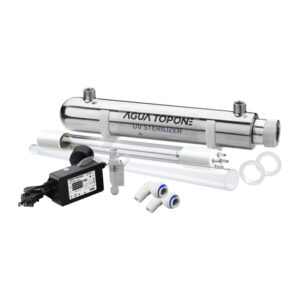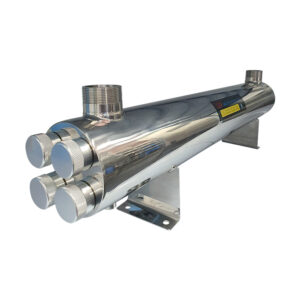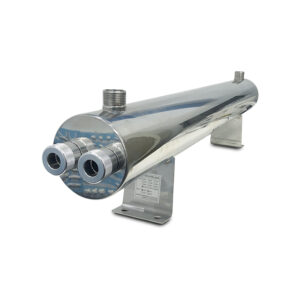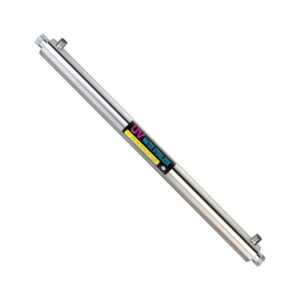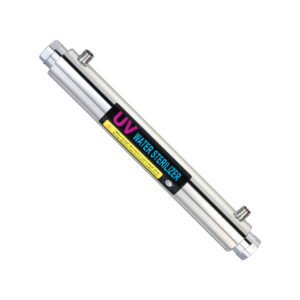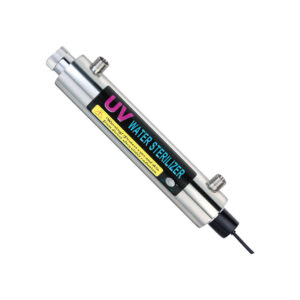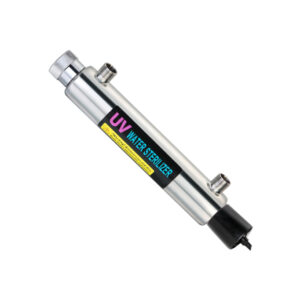Currently Empty: R0.00
KILL BACTERIA IN
YOUR EVERYDAY
WATER
What is Ultraviolet Sterilization?
Ultraviolet sterilization is considered to be one of the most effective water treatment methods for disinfection. UV sterilizers work quickly in targeting and stabilizing all biological impurities found in water. Additional chemicals are not needed, therefore saving costs, including containing no danger of overdosing.
Ultraviolet or UV water sterilizer are used in water purification and treatment to make water healthier and prolong the life of water that has been treated and processed. The word “sterile” is defined as being free from living germs or microorganisms. An Ultraviolet sterilizer extraordinarily cleans water and kills bacteria and microorganisms that can be able to infest water even after it has been treated.
UV is a type of energy found in the electro-magnetic spectrum, lying between x-rays and visible light. Although we cannot see Ultraviolet light or rays, we are exposed to them every time we step out into the sun. In fact, Ultraviolet light is responsible for causing sunburns.
UV Water Purification systems use special lamps that emit UV light of a particular wave-length that has the ability, based on their length, to disrupt the DNA of micro-organisms. As water passes through a UV water treatment system, living organisms in water are exposed to UV light which attacks the genetic code of the microorganism and rearranges the DNA /RNA, eliminating the micro- organism’s ability to function and reproduce. If a microorganism can no longer reproduce, it cannot replicate, therefore it cannot infect other organisms with which it has contact. This process of exposing water to Ultraviolet light is simple but effective, destroying 99.99% of harmful microorganisms without adding any chemicals to the water.
UV Products
How Does UV Sterilization Work?
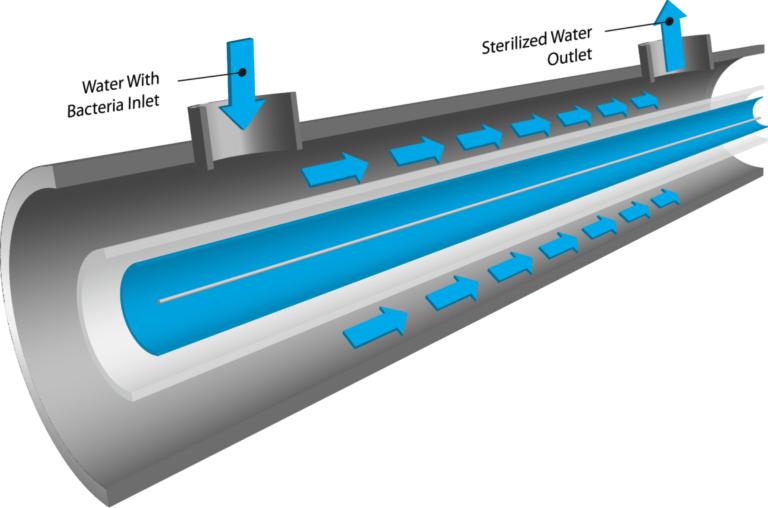
Many water purification systems take advantage of a UV water sterilizer even after processing their water. This is a well-known practice. Companies like Puritech highly recommend UV sterilizers as a post-treatment when treating water. Throughout the year’s ultraviolet technology has become well established as a chosen method for effective and economical water disinfection. Ultraviolet water sterilization claims many advantages: All microorganisms are virtually susceptible to ultra-violet disinfection.
For every penny of operating cost, hundreds of gallons of water are purified. NO additional chemicals are added and there’s no danger of overdosing. Once the water leaves the purifier, it is ready for use with no further contact time required. It has simple and easy to install and maintain. Compact units need a small space to operate and store. Ultraviolet water sterilizers deliver ongoing disinfection without special attention or measurement. There are no detections of chlorine taste or corrosion problems.
UV Disinfection System is an extremely effective way to combat microbial contamination in water. However, microbes have to be exposed to UV-C light in the proper amount in order to effectively disinfect the water. UV Disinfection Systems are used in many different applications ranging from the purification of drinking water in individual homes to disinfecting water supply of entire townships to industrial wastewater treatment. UV treatment for water is recognized as a safer and more cost-effective way to disinfect water for industrial applications
Why Use UV In Water
Water Bottling Plants
Cooking Water
If I’m On City Water
- Water main breaks and broken pipes are a major cause for boil water advisories.
- There are over 850 water main breaks every day in South Africa, and boil water advisories often aren’t issued for 24-48 hours after the contamination has occurred.
- Out of the homes that have a water filtration device, only 10% have a system that can effectively protect against bacteria.
- An Ultraviolet water filter system will protect your family from harmful bacteria even during a boil water advisory.
If I’m On Well Water
- Wells are susceptible to bacteria from many sources.
- Improper well casing, casing corrosion, and poorly-installed well caps are common sources for well water contamination.
- Water levels change and fluctuate over time exposing the well to new opportunities for bacteria growth.
- Bacteria, including total coliform bacteria and E. coli, were found in one third of wells, according to the US Geological Survey.
The UV Advantages
- Destroys 99.99% of microorganisms.
- Once installed, annual service is usually all that is required
- Chemical disinfection methods change the taste & odor of water but UV does not
- Only lamp & sleeve replaced annually
- No disinfection byproducts and no wasted water
- Works night and day, 24/7, consistently keeping water safe
- Water flows through the system with essentially no pressure loss and requires no separate holding tank
- No handling of chemicals
Applications Of A UV Sterilizer
Domestic Use
Commercial Use
Industrial Use
Parts Of The UV System
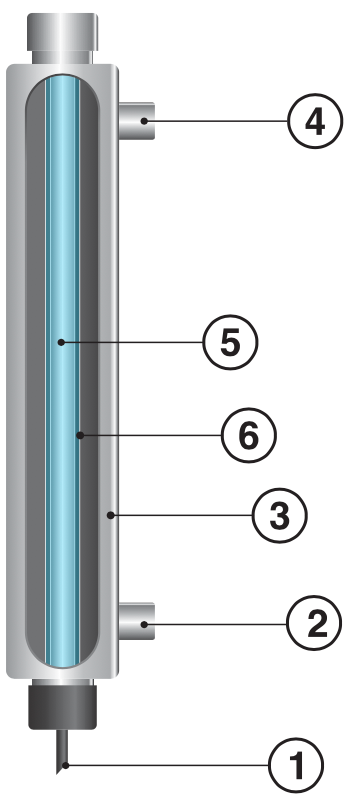
1. Ultraviolet Power Supply Unit
This is the main control of the Ultraviolet system. Some systems have a very simple controller, and others have a more complicated system that includes alarms, lamp change timers, trouble indicator lights, and more. Although Ultraviolet units vary in complexity and size, all controllers do basically the same thing of controlling the electrical output of the lamp and powers the UV-C light needed for water purification.
2. Inlet for untreated water
3. UV System Housing
4. Outlet for treated (clean) water
5. UV Bulb
The lamp of a UV system produces UV-C, which is Ultraviolet light considered to be germicidal. However, different lamps perform different functions, so the type of lamp used will be contingent on the application and disinfection requirements.
6. UV Quartz Sleeve
The quartz sleeve is made of quartz glass and is there to protect the UV lamp which is powered by electricity from the flow of water. The UV lamp transmits light through the tube into the water. It is important to clean the sleeve (generally when the lamp is changed) as minerals and contaminants in the water can cloud the glass tube.
What Does UV Remove?
UV is a safe, chemical-free way to treat water. Best of all, UV is effective in destroying 99.99% of harmful microorganisms, including:
- E. coli
- Giardia
- Viruses
- Flu
- Typhoid Fever
- Dysentery
- Polio
- Cryptosporidium
- Cholera
- Infectious Hepatitis
- Salmonella
- Cysts
- Salmonella
- Meningitis
- Coliform
How to Get the Best Results From Your UV System
An ultraviolet water disinfection system cannot remove sediment, hardness, iron, lead or chlorine. That’s why pre-filters are often installed before a UV system.
Sediment
Sediment found in city and well water can be large enough to create shadows for bacteria to hide behind and thus, hinder the systems’ ability to effectively treat water. UV manufacturers highly recommend a re-sediment filter be installed before the UV system to ensure proper water treatment.
Hard Water
If you have hard water, it may be necessary to have a water softener installed before the UV system. Hard water can cause scale build-up on the UV lamp which decreases the efficiency of the ultraviolet process.
Industrial Applications of UV Disinfection System
Ultraviolet disinfection system is not simply a lamp inside a pipe. The UV Reactor must be designed to ensure that all microbes receive sufficient exposure to the UV light (dose). Based on the hydraulic properties of water; the reactor needs to be optimized to guide the flow in a manner so as to maximize residence time and boost turbulence. Well designed Industrial UV water disinfection systems are producing consistently exceptional results in the industrial applications
Other Applications of UV Disinfection System
- Food and Beverage – UV disinfection system can help to achieve a High-quality of water as per specifications laid down by the FDA
- Bio- Pharmaceutical – Water used in Pharmaceutical and healthcare products and for CIP (Cleaning in Place) must be free of chemicals like chlorine, ozone, and pathogens. Most pharmaceutical companies depend on UV systems for water disinfection.
- Cosmetics – Water that is free of microorganisms and toxins ensures quality and enhances the shelf life of cosmetics. UV Sterilization is the preferred choice for the cosmetic industry across the globe.
- Centralized Drinking Water – A UV drinking water disinfection system is an easy, affordable solution to ensure pure water in each and every tap of your home or office
- Waste Water Disinfection and Reuse – To combat the problems of water scarcity and the rising cost of fresh water, UV Disinfection can help by treating wastewater in the tertiary stage. UV systems that are specially designed for wastewater can thus disinfect wastewater so that the water can be reused for secondary purposes such as flushing and gardening.
- Swimming Pools – Traditionally, chlorine has been in use to ensure clean water in swimming pools. However, it is increasingly being known that with chemical disinfection, chemical reacts with many other organic matters to form hundreds of new chemicals which are harmful. While UV is recognized as a safer and more cost-effective way to disinfect swimming pools.


